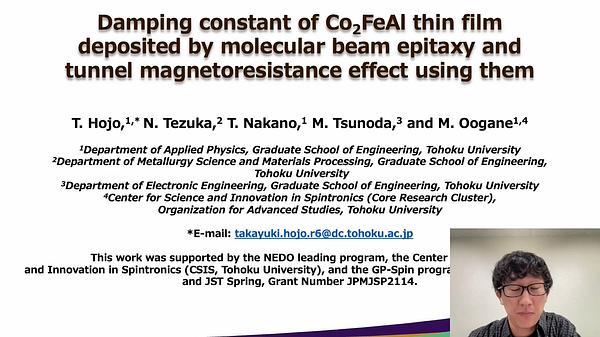Would you like to see your presentation here, made available to a global audience of researchers?
Add your own presentation or have us affordably record your next conference.
Antiferromagnets have unique attributes such as high-speed dynamics and small stray fields, forming a new paradigm of spintronics (1,2). In particular, non-collinear antiferromagnets with chiral spin structures have attracted increasing attention as they exhibit various intriguing topological phenomena (3,4). Recent studies also demonstrated current-induced reversal (5) and rotation (6) of the chiral-spin structure in thin-film systems. An important issue that has remained to be explored is the stability of antiferromagnetic spin structure against thermal fluctuation, which determines the retention time of the spin structure as well as the critical current for the electrical manipulation. Here, we fabricate non-collinear antiferromagnetic D019-Mn3Sn nanodots with various diameters and measure their thermal stability factor Δ.
We deposit W(2)/Ta(3)/Mn3Sn(20)/MgO(1.3)/Ru(1) (in nm) on MgO(110) substrate by magnetron sputtering (7), followed by annealing at 500 oC for an hour. We confirm the M-plane-oriented epitaxial growth of Mn3Sn layer by X-ray diffraction. The stack was processed into circular dot devices with a diameter D of 175-1000 nm using electron beam lithography and Ar ion milling. Figure 1 shows Hall resistance RH as a function of the magnetic field H for different D together with the scanning electron microscopy (SEM) image. We then evaluate Δ of Mn3Sn dot through the measurement of switching probability versus amplitude of pulse magnetic field. For the analysis, we assume a six-fold in-Kagome-plane anisotropy to model the magnetostatic energy of Mn3Sn. Figure 2 shows D dependence of Δ. The reduction of Δ at D of less than about 300 nm is observed, indicating a single domain reversal of spin structure in this scale, consistent with a previous report on Mn3Sn nanowire (8). Our result offers an important insight to understand the thermal activation of antiferromagnets, allowing one to design reliable and efficient antiferromagnetic devices.
This work was partly supported by JSPS Kakenhi (Nos. 19H05622 and 22K14558), Casio foundation (No. 39-11), and RIEC Cooperative Research Projects.
References:
(1) T. Jungwirth et al., Nat. Nanotechnol. 11, 231 (2016).
(2) V. Baltz et al., Rev. Mod. Phys. 90, 015005 (2018).
(3) S. Nakatsuji et al., Nature 527, 212 (2015).
(4) A. Nayak et al., Sci. Adv. 2, e1501870 (2016).
(5) H. Tsai et al., Nature 580, 608 (2020).
(6) Y. Takeuchi et al., Nat. Mater. 20, 1364 (2021).
(7) J.-Y. Yoon et al., Appl. Phys. Express 13, 013001 (2020).
(8) H. Bai et al., Appl. Phys. Lett. 117, 052404 (2020).


